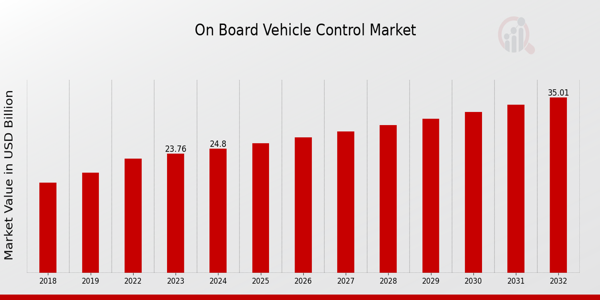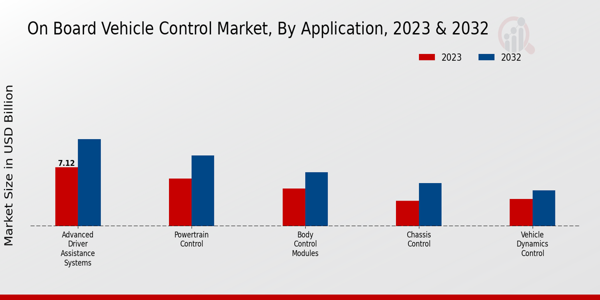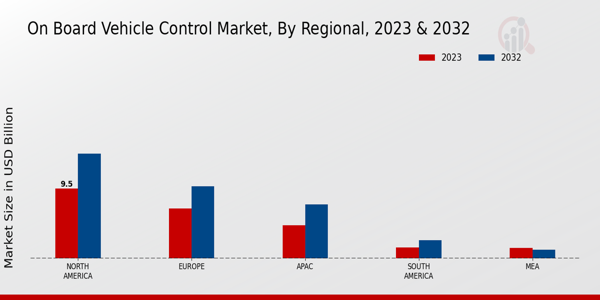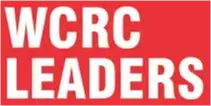On-Board Vehicle Control Market Overview
As per MRFR analysis, the On Board Vehicle Control Market Size was estimated at 25.91 (USD Billion) in 2024. The On Board Vehicle Control Market Industry is expected to grow from 27.06 (USD Billion) in 2025 to 39.94 (USD Billion) till 2034, at a CAGR (growth rate) is expected to be around 4.42% during the forecast period (2025 - 2034).
Key On-board Vehicle Control Market Trends Highlighted
The On-board Vehicle Control Market is experiencing significant growth driven by several key market drivers. The increasing demand for advanced safety features in vehicles, driven by stricter regulations and consumer awareness, has led manufacturers to invest in onboard control systems.
Additionally, the rise of electric and hybrid vehicles is propelling the need for sophisticated control systems that can manage energy consumption and performance efficiently.
Moreover, the integration of advanced driver-assistance systems (ADAS) is becoming essential for manufacturers aiming to enhance vehicle safety and user experience. These factors contribute to a vibrant market landscape.
Opportunities to be explored include the growing trend of vehicle electrification and the development of autonomous vehicles. As more consumers shift toward eco-friendly transport solutions, the requirement for control systems that can optimize energy use and support autonomous functions is becoming apparent.
Companies can capitalize on this trend by innovating and integrating their technologies with artificial intelligence and machine learning. This presents a pathway for creating more advanced systems that not only improve driving safety but also increase fuel efficiency and vehicle performance. Trends in recent times indicate a strong shift towards connectivity in vehicles.
The rise of the Internet of Things (IoT) has enabled vehicles to communicate with each other and their surroundings, creating a need for robust on-board control systems. This connectivity trend allows for improved traffic management and enhances the overall driving experience.
Furthermore, the growing popularity of over-the-air (OTA) updates is pushing manufacturers to develop systems that can adapt to changing needs and functionalities. This evolution in vehicle technology is indicative of a broader trend towards smarter, more adaptable onboard control systems in the automotive industry.

Source Primary Research, Secondary Research, MRFR Database and Analyst Review
On-board Vehicle Control Market Drivers
Advancements in Vehicle Technology
The On-board Vehicle Control Market is experiencing significant growth driven by advancements in vehicle technology. Modern vehicles are increasingly equipped with sophisticated onboard control systems that enhance driving efficiency, safety, and comfort.
Innovations such as advanced driver-assistance systems (ADAS), which incorporate features like lane-keeping assist, adaptive cruise control, and automatic emergency braking, are transforming the driving experience.
Additionally, the integration of technologies such as artificial intelligence and machine learning into vehicle control systems allows for more precise control and operation of vehicles. This trend is being fueled by the automotive industry's shift towards automation and smart mobility solutions.
As consumers demand higher safety standards and enhanced performance from their vehicles, manufacturers are compelled to invest heavily in research and development, leading to an expanding array of advanced onboard vehicle control technologies.
With the projected growth in market valuation and the continued evolution of vehicle functionalities, there is a promising trajectory for the On-board Vehicle Control Market. This growth is expected as more vehicles integrate these advanced control features, making them a pivotal driver for future expansion.
Increase in Automobile Production
A notable driver for the On-board Vehicle Control Market is the increase in automobile production across the globe. As more manufacturers ramp up production to meet rising consumer demand, the need for enhanced vehicle control systems escalates.
This uptick in production not only reflects a growing market for vehicles but also signifies a growing need for sophisticated onboard controls that ensure optimal performance and safety standards. The rising consumer preference for high-quality vehicles equipped with advanced features further accelerates this trend, necessitating innovations in vehicle control systems.
Regulatory Compliance and Safety Standards
The emphasis on regulatory compliance and safety standards in the automotive industry acts as a crucial driver for the growth of the On-board Vehicle Control Market. Governments worldwide are implementing stringent regulations concerning vehicle safety, emissions, and technological capabilities to protect consumers and reduce environmental impacts.
These regulations compel manufacturers to incorporate advanced onboard vehicle control systems that not only ensure adherence to safety standards but also enhance the environmental sustainability of vehicles. Consequently, this regulatory push fosters a robust demand for advanced technologies, influencing the dynamics of the On-board Vehicle Control Market.
On-board Vehicle Control Market Segment Insights
On-board Vehicle Control Market Application Insights
The On-board Vehicle Control Market is segmented into various applications that are critical for enhancing vehicle performance and safety.
The Advanced Driver Assistance Systems (ADAS) application held a significant portion of this market, valued at 7.12 USD billion in 2023. This segment was crucial as it included systems designed to improve vehicle safety and facilitate driving, which have become paramount in consumer preferences, leading to its dominant position.
Following ADAS, the Powertrain Control application was valued at 5.76 USD billion, emphasizing its importance in managing engine and transmission performance, thus significantly impacting vehicle efficiency and emission reduction efforts.
The Body Control Modules, valued at 4.51 USD billion, played a vital role in controlling various vehicle functions such as lighting and climate systems, underlining their importance for user comfort and convenience.
Meanwhile, the Chassis Control segment, valued at 3.07 USD billion, was essential for maintaining vehicle stability and control, influencing driving dynamics and safety features.
Lastly, the Vehicle Dynamics Control application, which was valued at 3.3 USD billion, played a significant role in enhancing vehicle handling and safety characteristics.
As the market evolves, trends such as increased integration of connected technologies and automation are expected to drive further growth, presenting substantial opportunities for industry players, while challenges may include the complexity of systems integration and regulatory compliance.
Each application within the On-board Vehicle Control Market showcases significant potential for advancement, with a clear trend towards enhanced safety, efficiency, and user experience driving their respective developments.

Source Primary Research, Secondary Research, MRFR Database and Analyst Review
On-board Vehicle Control Market Vehicle Type Insights
Market segmentation highlights various vehicle types, including Passenger Vehicles, Commercial Vehicles, Electric Vehicles, and Hybrid Vehicles, each showing distinct trends and growth patterns.
Passenger Vehicles are pivotal as they dominate the market due to rising consumer preference for comfort and technology integration. Meanwhile, Commercial Vehicles are gaining traction with the e-commerce boom, necessitating efficient logistics and fleet management solutions.
Electric Vehicles are becoming increasingly significant as sustainability concerns drive innovation and investment, focusing on reducing emissions and fuel dependence. Hybrid Vehicles serve as an important transitional technology appealing to consumers aimed at optimizing efficiency.
As the On-board Vehicle Control Market statistics reveal a steady increase in technological advancement, the need for reliable control systems becomes even more crucial, addressing both modern consumer demands and regulatory requirements.
On-board Vehicle Control Market Control System Type Insights
The market segmentation reveals critical insights into Control System Types, which include Electronic Control Units, Distributed Control Systems, and Centralized Control Systems. The Electronic Control Unit is increasingly significant due to its essential role in managing vehicle functions, thus dominating the market.
With advancements in vehicle technology, the Distributed Control System is gaining traction for its flexibility and efficiency in overseeing multiple processes, appealing to manufacturers aiming for enhanced performance.
Centralized Control System also plays a vital role, streamlining operations and offering convenience by integrating various systems under a single platform. The growth of the On-board Vehicle Control Market is driven by trends towards automation and electric vehicles, with increasing demand creating opportunities for technological advancements.
However, challenges such as high development costs and the need for skilled labor must be addressed to optimize this evolving market landscape. Overall, the On-board Vehicle Control Market data reflects a robust trajectory fueled by innovative control systems that redefine vehicle functionalities and enhance driver experience.
On-board Vehicle Control Market End Use Insights
The market segmentation focused on End Use highlights critical areas such as Personal Use, Fleet Management, and Public Transport. Personal Use significantly contributes to the market, driven by the increasing adoption of smart technologies in vehicles.
Meanwhile, Fleet Management is gaining traction due to the rising need for efficiency and cost-effectiveness in commercial operations; this segment increasingly relies on advanced control systems for tracking and managing vehicles.
Public Transport also plays a vital role, as cities globally invest in automated and efficient systems to enhance commuter experiences. Growth drivers include technological advancements, urbanization, and a push toward sustainable transport solutions.
Despite these opportunities, challenges such as regulatory hurdles and high implementation costs may impact market growth. Overall, the On-board Vehicle Control Market statistics demonstrate substantial potential for evolution, with each End Use segment contributing uniquely to the industry's development.
On-board Vehicle Control Market Regional Insights
The Regional segment of the On-board Vehicle Control Market is projected to showcase a robust valuation, with North America leading at 9.5 USD billion in 2023 and expected to grow to 14.2 USD billion by 2032, reflecting its dominance in innovation and technology development in vehicle control systems.
Europe followed closely, with a market value of 6.8 USD billion in 2023, anticipated to reach 9.8 USD billion in 2032, fueled by stringent regulations and a push towards electric vehicles. The APAC region exhibited significant growth potential, valued at 4.5 USD billion in 2023 and projected to grow to 7.3 USD billion by 2032, driven by rising automotive production and consumer demand.
Meanwhile, South America, with a market valuation of 1.5 USD billion in 2023 and MEA at 1.46 USD billion, showcased smaller but vital markets, indicating a growing interest in vehicle technology enhancements.
The On-board Vehicle Control Market data indicates that while North America and Europe dominate, APAC's growth trajectory presents substantial opportunities for industry players. These statistics emphasize the diverse landscape and the regional dynamics affecting market growth.

Source Primary Research, Secondary Research, MRFR Database and Analyst Review
On-board Vehicle Control Market Key Players and Competitive Insights
The On-board Vehicle Control Market is a dynamic sector that is continuously evolving in response to advancements in automotive technology and increasing consumer expectations. With a heightened emphasis on safety, efficiency, and user experience in modern vehicles, the landscape is characterized by several key players striving for innovation and market share.
As the automotive industry shifts towards electric and autonomous vehicles, the demand for sophisticated on-board vehicle control systems has surged, leading to intense competition among manufacturers.
Companies are leveraging cutting-edge technologies such as artificial intelligence, big data, and IoT to enhance vehicle performance and control while meeting regulatory requirements and consumer demands for sustainability and connectivity.
Mitsubishi Electric has established a formidable presence within the On-board Vehicle Control Market, leveraging its extensive expertise in electrical and electronic systems. Known for its innovation, Mitsubishi Electric focuses on integrating advanced technologies that optimize performance and ensure the highest safety standards.
The company excels in the development of various control systems, including advanced driver-assistance systems that enhance vehicle safety and operational efficiency. Additionally, Mitsubishi Electric's commitment to sustainable solutions and energy-efficient systems positions it well in a market increasingly focused on green technology.
They harness a well-structured research and development framework to continuously improve their offerings, providing a competitive edge in the rapidly evolving automotive landscape. Visteon is another key player in the On-board Vehicle Control Market, recognized for its strong focus on providing state-of-the-art technology solutions for connected and autonomous vehicles.
With a robust product portfolio that includes instrument clusters, infotainment systems, and advanced vehicle control technologies, Visteon is positioned as a leader in the integration of software and hardware solutions.
The company's expertise in digital cockpit technology differentiates it from competitors, allowing vehicles to deliver enhanced user experiences through intuitive interfaces and seamless connectivity.
Additionally, Visteon's strategic partnerships with automotive manufacturers enhance its market presence and allow the company to remain at the forefront of innovative developments in vehicle control systems, ensuring that it meets the growing demand and changing expectations of consumers in the automotive sector.
Key Companies in the On-board Vehicle Control Market Include
- Mitsubishi Electric
- Visteon
- Robert Bosch
- ZF Friedrichshafen
- Texas Instruments
- Hitachi Automotive Systems
- Denso
- Continental
- Electrobit
- Infineon Technologies
- Delphi Technologies
- NXP Semiconductors
- Garmin
- Aptiv
- Tata Elxsi
On-board Vehicle Control Market Developments
The On-board Vehicle Control Market has seen significant activity recently, particularly among leading companies such as Mitsubishi Electric, Visteon, Robert Bosch, and ZF Friedrichshafen. Notably, there have been advancements in autonomous driving technologies, with various firms investing heavily in AI and machine learning for enhanced vehicle control systems.
Companies like Denso and Continental are focusing on collaborative innovations in electric and hybrid vehicles. In terms of merger and acquisition activities, there have been several strategic moves, with Bosch acquiring a stake in a tech startup specializing in vehicle electrification, aiming to strengthen their position in the growing electric vehicle segment.
Likewise, NXP Semiconductors has broadened its portfolio through a merger with a software firm, enhancing its capabilities in vehicle-to-everything (V2X) communication technologies.
Growth in the market valuation of these companies is significantly impacting the industry landscape, reflecting robust demand for advanced onboard control systems driven by rising consumer preferences for safety, connectivity, and automation in vehicles.
This evolving market environment suggests sustained competition and innovation among key players, solidifying the importance of strategic partnerships and technological advancements.
On-board Vehicle Control Market Segmentation Insights
On-board Vehicle Control Market Application Outlook
- Advanced Driver Assistance Systems
- Powertrain Control
- Body Control Modules
- Chassis Control
- Vehicle Dynamics Control
On-board Vehicle Control Market Vehicle Type Outlook
- Passenger Vehicles
- Commercial Vehicles
- Electric Vehicles
- Hybrid Vehicles
On-board Vehicle Control Market Control System Type Outlook
- Electronic Control Unit
- Distributed Control System
- Centralized Control System
On-board Vehicle Control Market End Use Outlook
- Personal Use
- Fleet Management
- Public Transport
On-board Vehicle Control Market Regional Outlook
- North America
- Europe
- South America
- Asia Pacific
- Middle East and Africa
On-board Vehicle Control Market Report Scope
| Report Attribute/Metric |
Details |
|
Market Size 2024
|
25.91 (USD Billion)
|
|
Market Size 2025
|
27.06 (USD Billion)
|
|
Market Size 2034
|
39.94 (USD Billion)
|
|
Compound Annual Growth Rate (CAGR)
|
4.42% (2025 - 2034)
|
|
Report Coverage
|
Revenue Forecast, Competitive Landscape, Growth Factors, and Trends
|
|
Base Year
|
2024
|
|
Market Forecast Period
|
2025 - 2034
|
|
Historical Data
|
2019 - 2023
|
| Market Forecast Units |
USD billion |
| Key Companies Profiled |
Mitsubishi Electric, Visteon, Robert Bosch, ZF Friedrichshafen, Texas Instruments, Hitachi Automotive Systems, Denso, Continental, Electrobit, Infineon Technologies, Delphi Technologies, NXP Semiconductors, Garmin, Aptiv, Tata Elxsi |
| Segments Covered |
Application, Vehicle Type, Control System Type, End Use, Regional |
| Key Market Opportunities |
Rising electric vehicle adoption, Advancements in autonomous technology, Growing demand for connectivity, Increasing safety regulations, Emerging markets expansion |
| Key Market Dynamics |
Technological advancements, Increasing demand for automation, Stringent safety regulations, Growth in electric vehicles, Rising consumer awareness |
| Countries Covered |
North America, Europe, APAC, South America, MEA |
Frequently Asked Questions (FAQ) :
The On-board Vehicle Control Market is expected to be valued at 39.94 USD billion by the year 2034.
The market is expected to grow at a CAGR of 4.4% from 2025 to 2034.
North America is projected to dominate the market with an expected value of 14.2 USD billion by 2032.
The market for Advanced Driver Assistance Systems was valued at 7.12 USD billion in 2023 and is projected to reach 10.5 USD billion by 2032.
Major players include Mitsubishi Electric, Visteon, Robert Bosch, ZF Friedrichshafen, and Texas Instruments.
The market for Powertrain Control is expected to reach 8.5 USD billion by 2032.
The Body Control Modules segment is expected to be valued at 6.5 USD billion by 2032.
The APAC region is projected to reach a market value of 7.3 USD billion by 2032.
The Vehicle Dynamics Control segment is expected to grow to 4.3 USD billion by 2032.
In 2023, the market value for Chassis Control was 3.07 USD billion, projected to increase to 5.2 USD billion by 2032.





























